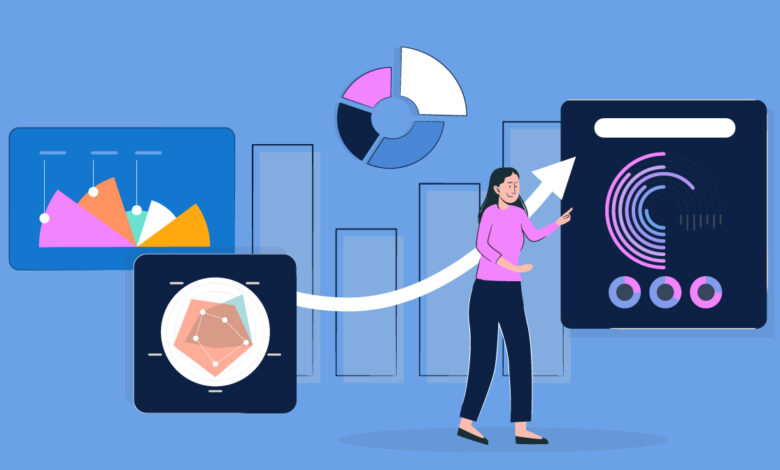How to Use Data Visualization Effectively

Human attention is overloaded with information flows. News reports, interesting information, statistics, and other scattered facts reduce the quality of information assimilation. In business, this is a tricky issue. In the general flow, you can not see the important data. To bring different indicators into a form convenient for presentation, study, and analysis, visualization tools are used. If you are interested in high-quality data visualization and are looking for a data visualization services provider, then this article is for you.
Why Data Visualization Is Important
Data visualization is a graphical representation of data in forms that contribute to a more effective and versatile study. These can be images, animations, graphs, charts, maps, charts, and other tools to make complex processes understandable.
Benefits of data visualization tools:
- placement of graphic accents on important indicators;
- analysis of large arrays of complex data;
- keeping attention;
- reducing the level of information saturation;
- clear unambiguous conclusions from the information provided;
- evidence of internal links between information blocks;
- combining unstructured information into one visual image;
- the impetus for quick but effective analytics.
Main Principles of Data Visualization
There are many ways to visualize data, as well as tools for more effective visualization, including AI, virtual reality, and so on. Let’s look at the basic principles on which data visualization is based.
Data Clarity
Graphic schemes combine a large amount of information. At the same time, the picture is not enough, explanations, and subtext, reflecting the essence of the described event, are needed. A common mistake is an attempt to paint everything at once, overloading the visual picture, and diverting attention from visibility. In order to maintain clarity, explanations should be minimal and to the point, in the form of brief indications of what is being said. Let the information be reflected less, but it will be accurate and of high quality.
Less Visual Noise
Don’t go overboard with extra graphical elements such as shadows, 3D, grids, gradient transitions, icons, and background layering. All this is called visual noise, which, by analogy with sound, distracts from the main information and reduces the quality of perception.
Graphics And Text Must Be One
Any graphic display implies a story that explains and complements it. When creating presentations or boards with analytics, there is a slide structure, when an image is presented on one slide, and text explaining it on another or on a pop-up window. The viewer will have to independently compare the two options for presenting the material, and look for connections. This will reduce the speed of perception and assimilation. Graphics and text should complement each other, and become a single presentation picture, where it is immediately clear what each line, column, dot, or icon reflects.
Characteristics That Can Be Determined Immediately
The human perception of information is arranged in such a way that at first, the brain notices what is already familiar to it. It can be previously learned forms, shades, and contrasts. After that, the eyes pick up other parameters of the object and analyze it as a whole. This feature must be taken into account when constructing graphical visual elements. It is necessary to focus on the key indicators that the audience should see first of all. For the same reason, do not place text vertically or at an angle. The viewer will have to turn his head, and this is at least inconvenient.
Visualization Methods And Data Types
The effectiveness of visualization depends on the correct choice of means and its relevance to the information presented. The purpose of the visual presentation is to better and more fully convey the idea that is contained in the information array. Therefore, you need to focus on the parameters of the analyzed data:
- Relationship. Graphs and charts reflect how information depends on each other, and how their values change when other conditions change. This is where flowcharts and bar charts with multiple variables come in handy.
- Distribution. Such information requires grouping according to various criteria. For example, categories of buyers or groups of goods. It can be a pie or bar chart.
- Composition. The reverse process of distribution is when you need to collect different indicators into a single picture.
- Comparison. Parallel readings are collected side by side for qualitative and quantitative comparison. For example, the performance of employees or structural units, and the effectiveness of marketing channels.
In addition to the purpose of the study, you need to understand the composition of the data. Their types are distinguished by nature and structure:
- Continuous numerical reflects the dependence of one numerical indicator on another.
- Continuous time contains information about processes that occur continuously over time, such as the readings of a site visitor counter.
- Discrete ones show finite values, for example, the revenue of one point of sale per day.
- Geographic combine information about geolocation, geological features, coordinates, and position of objects.
- Logical data is information about the relationships between information layers. For example, the administrative structure of the company.
Basic Visualization Methods
For the visual presentation of information, several techniques are used, including graphs, diagrams, flowcharts, and infographics. The first two are the most popular and universal.
Graphs
It is a display of information using two perpendicular axes with different values. Additional elements can be included in the structure of the graph, it can be modified for specific situations, so many different subspecies are used.
Diagrams
An extensive group of visualization types using axes, sectors, polar coordinates, various shapes, and other graphic elements. A variety of chart types allows you to find a technique for the visual presentation of almost any information with different analysis criteria.
Final Thoughts
To visualize data qualitatively, you need to follow the principles of presenting information. The ability to present information visually increases the productivity of their analysis. At the same time, manually compiling visual graphs and diagrams is laborious and time-consuming, so companies prefer to use digital tools, including those based on AI and with support for virtual reality. If you’re looking for a named data visualization services provider, you can turn to Mydigicode.com. The company’s experience allows the use of modern data visualization solutions such as AI, VR/AR, and many others.



